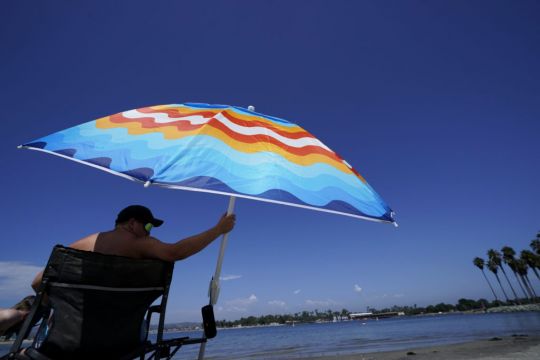Californians sweltering in a lengthening heatwave have been asked to reduce air conditioning and cut other electricity use during critical hours over the weekend to prevent stress on the state’s electrical grid that could lead to rolling blackouts.
Saturday will be the fourth consecutive day of requests by the state’s electrical grid operator for voluntary cutbacks during late afternoon and evening hours to balance supply and demand as millions of residents endure high temperatures.
The California Independent System Operator (Cal ISO) said multiple generators have been forced out of service because of the extreme heat, which has reached the high 30Cs in some places, making energy supplies tighter.
Electricity demand on Thursday hit a peak of 47,357 megawatts, the highest since September 2017. Cal ISO credited conservation and reduced commercial use with keeping the grid stable.
“The major concern now is even higher temperatures forecast for Sunday, Monday, and Tuesday, with projected loads climbing to more than 49,000 megawatts on Tuesday,” Cal ISO said in a statement.

In August 2020, a record heatwave caused a surge in power use for air conditioning that overtaxed the grid. That caused two consecutive nights of rolling blackouts, affecting hundreds of thousands of residential and business customers.
Governor Gavin Newsom on Wednesday declared an emergency to increase energy production and relaxed rules aimed at curbing air pollution and global warming gases. He emphasised the role climate change is playing in the heatwave.
The National Weather Service said: “September is off to a searing start in the West with record breaking temperatures and fire weather expected to expand and settle over that part of the country this Labour Day weekend.”
California’s “Flex Alerts” urge conservation between 4pm and 9pm, the hours when production of solar energy declines. The grid operator urges people to use major appliances, charge electric cars and cool down their homes earlier in the day, then turn up thermostats to 25.5C or higher.
Anne Gonzales, a spokeswoman for the grid operator, said: “The number one, most effective conservation measure is to set thermostats to 78F (25.5C) or higher” because air conditioners are the biggest users of electricity in the summer.

She added: “We have traditionally asked for 78F because it has a good effect on our demand, and is still comfortable to allow consumers to easily participate.
“We always ask consumers to set it higher, if they can, and if health permits.”
Keeping temperatures too low can cause air conditioners to run constantly, added Jay Apt, a professor at the Carnegie Mellon University College of Engineering.
“If you set that puppy too low, it’s going to run all the time,” he said. “That’s going to do two things, the first is that it is going to use an awful lot of energy and the second is that it’s not going to give recovery time.”
The goal is to allow units to cycle on and off, said Mr Apt, and 78F is a rough estimate for the sweet spot that can vary depending on a building’s insulation.
In California, customers of Pacific Gas & Electric, the nation’s largest utility, can volunteer to let the company control their internet-connected thermostats during heatwaves. The programme automatically adjusts the thermostat schedule so it uses less energy during times of peak demand.

Customers can get 75 US dollars (65) for participating and can opt out of it by simply changing their thermostat to a different temperature. The company does not lock thermostats.
California cities and counties, meanwhile, are opening cooling centres.
Dr Ori Tzvieli, health officer in Contra Costa County east of San Francisco, said: “We have opened cooling centres in the past, but this heatwave looks like it’s the real thing.”
Some of the centres will be specifically for homeless people, and an outreach team will also go out to hand out water to the homeless and inform them of available resources, Dr Tzvieli said.
Officials also said the heat would compound the effects of smog.
The Bay Area Air Quality Management District issued an alert for unhealthy levels of ozone pollution, especially for children, the elderly and those with respiratory and heart conditions.







